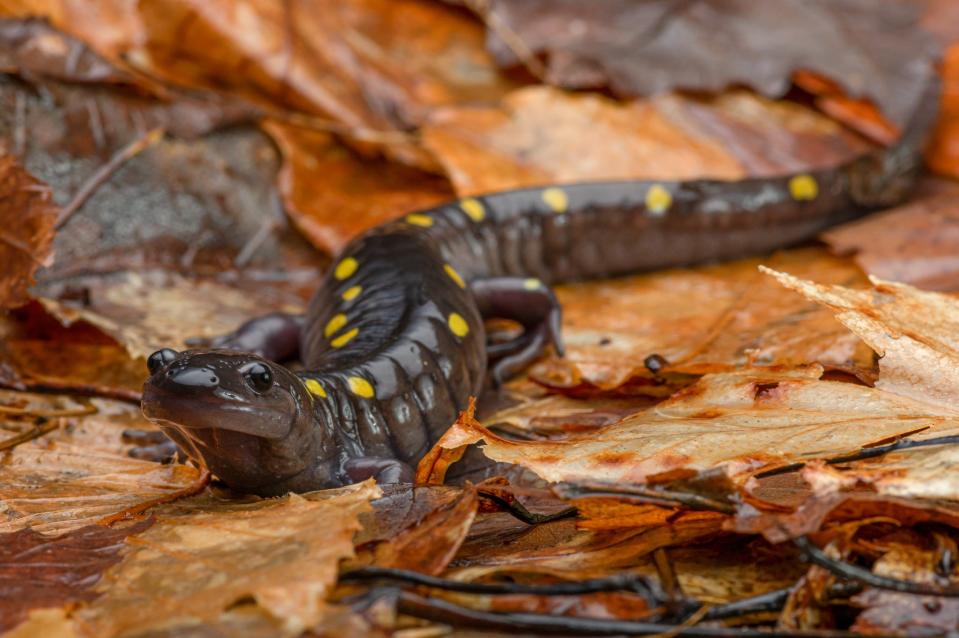The wet world of the salamander
“It is so chilly that it puts out fire by its contact, in the same way as ice does. It vomits from its mouth a milky slaver, one touch of which on any part of the human body causes all the hair to drop off, and the portion touched changes its color and breaks out in a tetter.”
“… for if it crawls up a tree, it infects all the fruit with poison and slays those who eat it; nay, even if it falls in a well, the power of the poison slays those who drink it.”
It “has no digestive organs, and gets no food but from the fire, in which it constantly renews its scaly skin.”

So said the Roman naturalist and philosopher Pliny the Elder, from about 2,000 years ago; Saint Isidore of Seville of the seventh century; and Leonardo Da Vinci, of the 15th century, each a learned savant speaking on the ferocious magic and mysterious powers of …
The salamander
The word itself stems from the Greek salamandra. Loosely translated as “fire-lizard” based on a body shape similar to that of a lizard, and on the ages-old belief that it survives (or even originates) in fire, salamanders were in days of old — and remain today — one of the least familiar groups of all vertebrates.
And this even though in some parts of the Eastern deciduous forest salamanders outweigh the accumulated mass of all other vertebrates combined. In the Southern Appalachians, densities can run as high as 2 salamanders per square meter of forest floor.
They can be that abundant, and yet remain unknown to the most avid trekker of the Appalachian Trail because, with a few notable exceptions, salamanders are small, secretive and commonly nocturnal.

One reason these amphibians are often confused with lizards is that, unlike frogs which absorb their tails when metamorphosing from the tadpole stage, salamanders keep their tails for life. However, while lizards are reptiles possessing scaly skin, teeth and claws, salamanders have a soft, porous skin and neither teeth nor claws.
They breathe through their skin
Their porous skin works both for and against them. On the one hand, they must always be immersed in water, or at least live in a wet environment, or they’d dry out. On the other hand, so long as their skin is kept moist, salamanders can essentially breathe through their skin in a process called cutaneous respiration.
In fact, two-thirds of salamanders don’t even have lungs, and cutaneous respiration is an especially useful trait for those aquatic salamanders that also don’t have gills. (All larval salamanders have gills, but only a few species, like the fully aquatic mudpuppies of area lakes and rivers, maintain them throughout life.)
Some salamanders live far from open water
Although many species keep close to woodland streams, various groups of terrestrial salamanders can live far from open water. Consider the spotted salamander found in many deciduous forests east of the Mississippi, and the red-backed salamander of similar woodlands in the Northeast as two examples.
Like all members of the so-called “mole salamander” genus, Ambystoma, the spotted salamander is a stout bodied animal (about 6-9 inches long) that spends most of its adult life in underground burrows where it hunts all manner of invertebrates. But in late winter and early spring, it migrates to vernal pools to breed.
These temporary wet spots formed by snowmelt are ideally suited to their needs: deep enough to provide food for their aquatic larvae, but too shallow and transitory for predatory fish. Although the larvae are defenseless, the adult’s yellow spots are a warning to would-be predators; glands in its skin exude non-lethal but bitter-tasting, noxious compound.
In contrast, the small (2-4 inches) red-backed salamander, typical of many members of the genus Plethodon, hunts for insects and worms on the forest floor on wet evenings after a summer rain, hiding beneath logs and rocks during the day.
Unlike the spotted, a female red-backed salamander lays her eggs under rotting logs or in a moist underground burrow where she coils herself around them for protection and to keep them moist. The larvae complete their gilled aquatic stage while inside the egg and hatch out looking like miniature adults.
So where did those myths about salamanders’ toxicity and association with fire come from? Probably the most common species in central Europe is the fire salamander, which spends much of its day hidden under woody debris on the forest floor.
It’s thought that when inadvertently collected with firewood, they’d scamper out of the hearth once the wood began to burn. Also, adults are well protected by neurotoxins produced by their skin, which can cause muscle contractions and convulsions in a predator.
Special glands near the head can even spray the noxious liquid into the eyes of an animal up to a foot away. Fortunately, the toxins only cause a mild irritation to the skin in humans ... unless ingested.
Ken Baker is a retired professor of biology and environmental studies. If you have a natural history topic you would like Baker to consider for an upcoming column, email your idea to fre-newsdesk@gannett.com.
This article originally appeared on Fremont News-Messenger: Salamanders look like a lizard but are far from it

